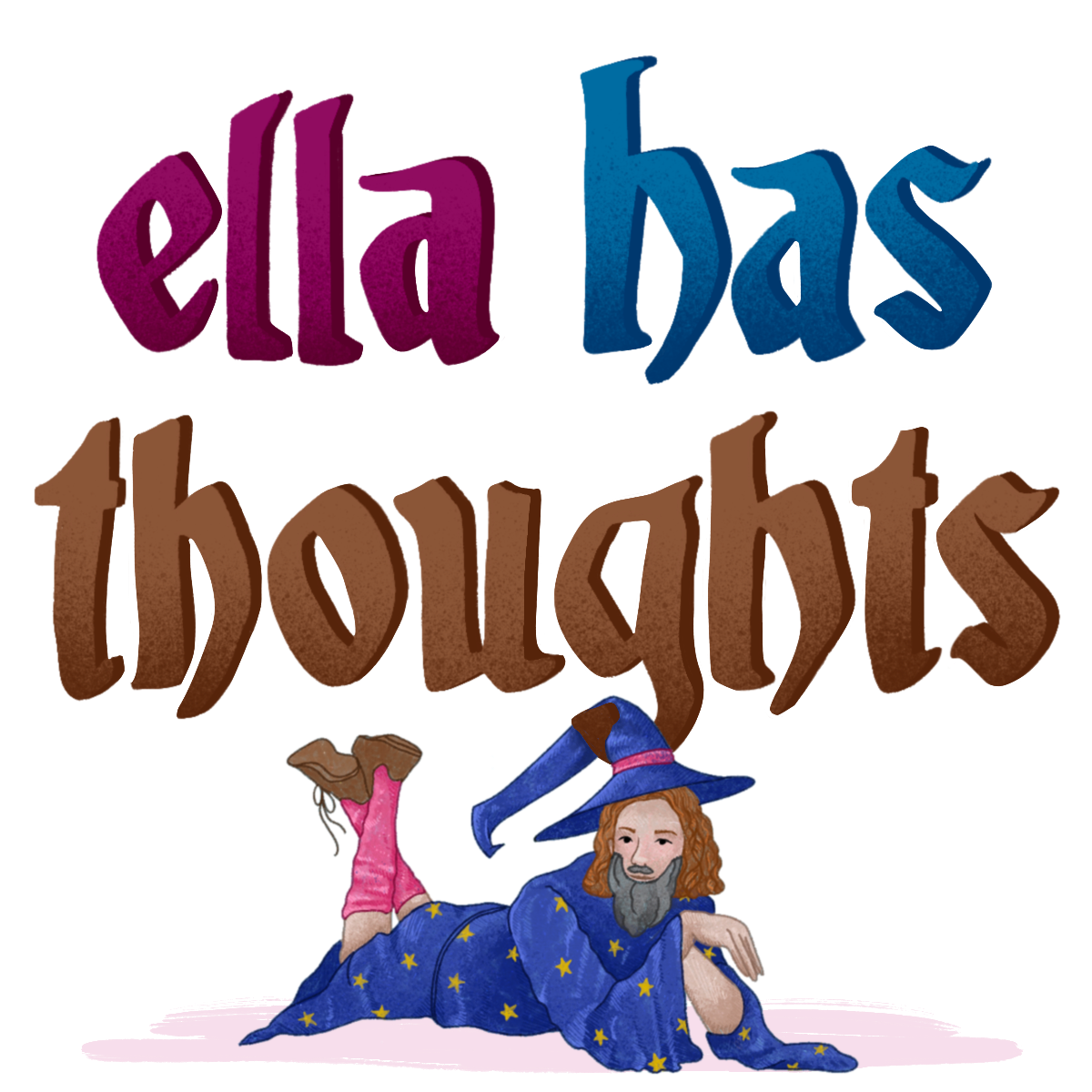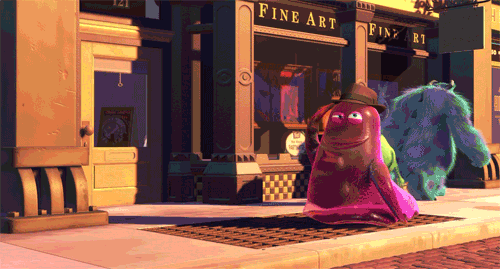Casual Ableism and Inaccessibility in Worldbuilding
Thoughts™️ about casual ableism and inaccessibility in worldbuilding, and how it often flies under the radar.
Hello, and welcome to another thought™ with ella. I'm your host, the gal in the sweater who asks all the obvious questions. (That one’s for fans of the Cat in The Hat live-action movie).
Today I wanted to talk about casual ableism and inaccessibility in worldbuilding.
It all started on a chilly Brisbane night when I was sat watching Monster’s Inc (2001) and got to the part very near the beginning where Mike and Sulley are walking to work, encountering a diverse range of monsters on the way…
Then we meet Blobby, a purple jelly monster, through this gag:
It seems funny, and I know someone out there is going to say “it’s not that deep”, but as someone who lives with a disability, it resonated with me even though I can’t relate to having my body literally sucked down through a grate on the street. Blobby is all set to traverse his path to work when he surprisingly finds himself unable to continue because the very foundation of the path, of the world he lives in, is not built to support or enable monsters like him.
In the real world, the first thing that comes to mind for me is how many paths, streets, buildings, and other infrastructure are not built to support people in wheelchairs, cane users, or other people with limited or different mobility.
When Blobby falls down, loses his body, and is robbed of autonomy, do you know what he says?
“Aw, great!”
Bobby says this and, judging by his tone, it seems like this isn’t an uncommon occurrence for him. Worse, it’s meant to be a joke. And listen, I know it doesn’t kill him. Maybe it doesn’t even hurt him physically! Whether it’s “that serious” is up to you to decide, but I do want to point out that casual and unintentional things like this show up repeatedly in our most popular media.
And when something shows up repeatedly in our most popular media, it becomes normalised, minimised, and more easily dismissible.
Now, I know someone out there will one day probably say “But Blobby isn’t disabled, so this is a stretch!”, but look. He may not have what is considered to be a disability, but he literally loses the ability to move. His able has been disqualified by the very structure of the city. Following the social model of disability studies, the grate, like stairs, is a social material condition that is restricting his movement. And if he wasn’t disabled before, he likely is now, at least for some measure of time.
In the world we live in, a world where ableism is so pervasively baked into our societies and cultures, it’s difficult not to be a bit ableist. Difficult, but not impossible. As creators, I believe we have a responsibility to be as respectful and responsible as possible with the things we’re putting out into the world. Plus, there are some easy and considerate things you can include or exclude that will make your worlds and narratives more accessible and inclusive.
This is not an exhaustive list, a worldbuilding checklist, or a listicle of hard-and-fast rules, nor do I think you should do these things and only these things. Depicting a truly inclusive world takes more than this.
Inclusive worlds present disability as valued diversity.
Also, I am but one person in this world, with my individual thoughts™️ and opinions.
Want to make a Blobby-like Gag of inaccessibility? Ask yourself why.
Personally, I don’t really like or appreciate these gags if they’re just there for a laugh. As a kid? Sure, I didn’t think much of it, but I also had more mobility and less education. As an adult who sees the impact of not being able to walk down the street because of needless obstacles? Who has experience with disability theory? No. Even in cartoons, I just feel bad for these guys, not warm-hearted and jolly.
If you’d like to include something like it, however, it’s a wonderful teaching moment, and it doesn’t even need to be overly long or didactic. Point it the problem and acknowledge it.
Stairs Are Made Up! You can’t spell ‘accessibility’ without ‘access’.
I know, it’s crazy. We literally just made stairs up, and they were accepted as the default.
Bare minimum, you could include ramps alongside stairs as entryways into buildings. Including ramps shows us that the building is more accessible and that people have choices about how they move in and out.
You can also describe your streets in such a way as to allow people to move without too much difficulty or risk of injury and death. It’s fine for many people to leap over giant cracks in the pavement, or step down from a raised path and onto a road, but how difficult might mobility be in those situations for people who have limited mobility? How dangerous and immobilising is a large drop in the path to someone who travels in a wheelchair?
If you’re writing fantasy, the only limit is your creativity! Do away with magic and inconveniently moving staircases and give us magic travelators! Elevators! Something!
Meanwhile, I photoshopped a nice street for Blobby and the rest of the monsters:
Avoid Accidental Able-body Supremacy.
Accidental able-body supremacy comes in many forms. For one, having an inaccessible world with no infrastructure for disabled folk is one way to reinforce that the world is built by and for able-bodied folk. If that’s intentional, sure. Accidental? Yikes.
An example might be situating a religious monument on the peak of a cliffy mountain, and having it so people must climb their way up with the belief that “only the most worthy may serve/ascend/be blessed”. You’ve excluded so many people. If you did something like this and didn’t realise that this means only able-bodied, uninjured people are “worthy”... now is the time to change that.
Be mindful of implications, and try not to unintentionally disqualify us from the community.
Show disabled people contributing to the world as-they-are.
Include knights with missing limbs. Include bakers who are hard of hearing. Include families who communicate through sign language. Do you know how often I read fantasy battles imagine the camera pan across the great wall they’re defending, and see even a hint of someone who isn’t able-bodied? Do you know how often I read books where we even glimpse someone casually using a wheelchair? Using a knee brace? It’s not as frequent as you might think!
Be mindful of tokenism…
Tokenism: “the policy or practice of making only a symbolic effort” (Merriam-Webster)
There’s more work that needs to be done. As I said earlier, this is not a complete list of things you should do. It’s best to do your research and put a good amount of effort in, with plenty of sensitivity and open-mindedness to the perspectives of others. There are plenty of disabled sensitivity readers out there who you can pay to read your book and give you honest feedback.
Got any of your own thoughts™️ on this topic? I’d love to hear from you! Discussion is one of the best ways to share perspectives and ideas.
Did you like the brain matter I’ve translated into words here in this post? Send it to a friend!


